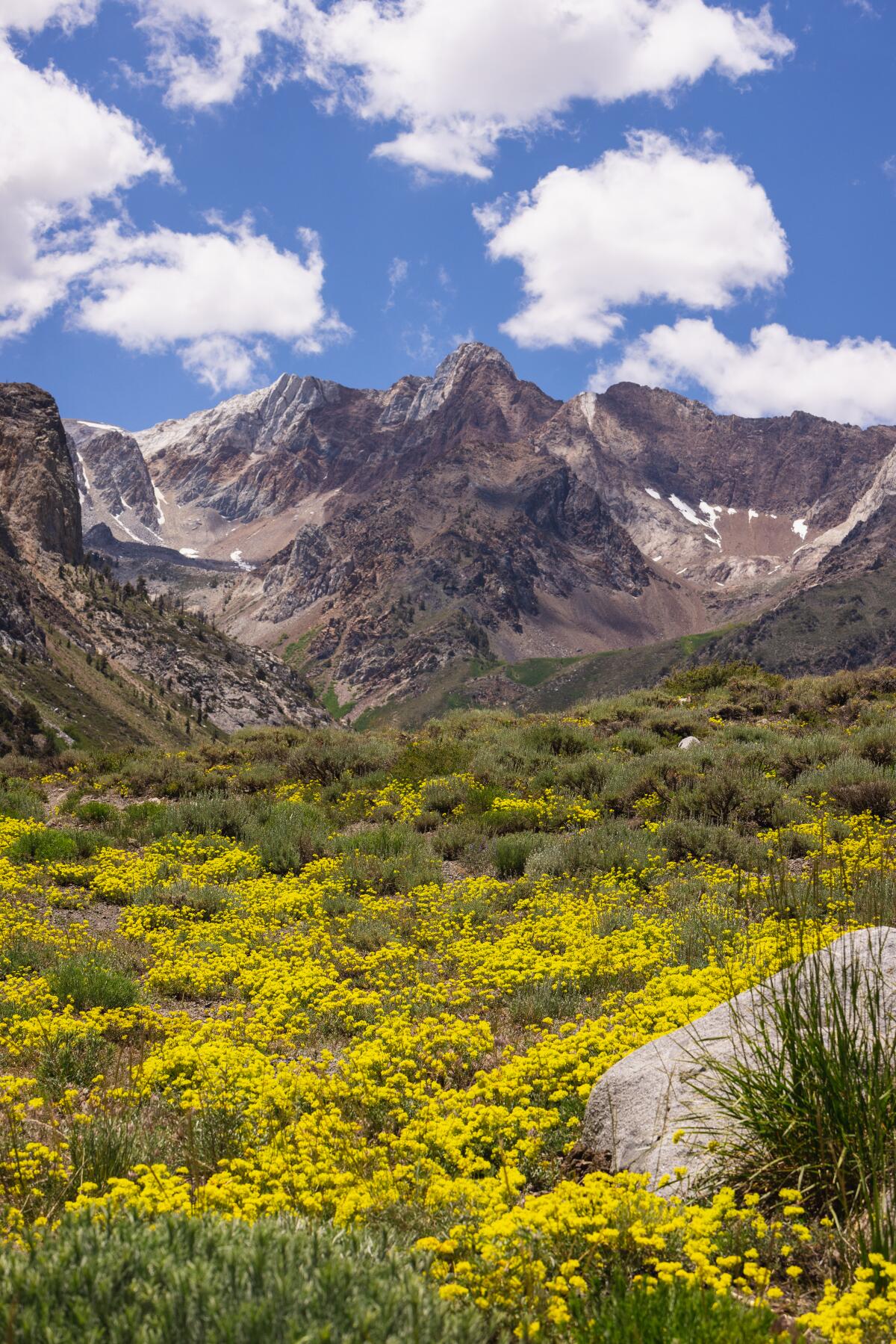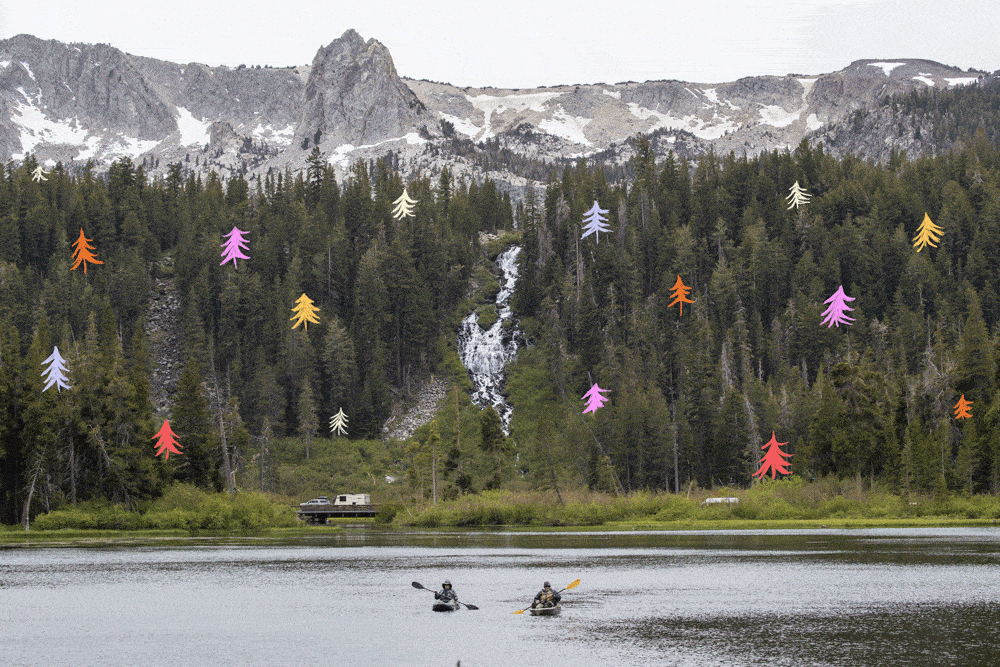It’s wildflower season in this Sierra mountain town

- Share via
Good morning, fellow Escapists. This spring proved fairly lackluster for California wildflower fans — a long way from 2019’s legendary superbloom.
Still, there were pockets of color, if you knew where to look.
In April, red chia, purple owl’s clover and yellow bush poppy graced Malibu Creek State Park. Just a few weeks ago, The Wild writer Mary Forgione wrote about a “surprise superbloom” she found in a badly burned section of the San Bernardino Mountains.
And, now, it’s Mammoth Lakes’ moment in the sun. Throughout the spring and summer, wildflowers pop up throughout the Sierra, shifting to higher altitudes in late July and August.
Yet Mammoth’s wildflowers are just one reason to make the 300-mile journey north from L.A.
For all its fame as a skiing destination, Mammoth really shines in summer, my colleague Christopher Reynolds wrote last week.
“It’s the best up here in the summer,” one boater told Reynolds during a recent visit to the Sierra mountain town. “Most people don’t know it. You can hike to a different lake every day.”
In this edition of Escapes, you’ll find where you may be able to spot some wildflowers, along with other ways to immerse yourself in Mammoth’s stunning natural beauty.
Where are you heading this summer? Send me an email, and I may pass your recommendation along in a future edition of Escapes.
Get inspired to get away.
Explore California, the West and beyond with the weekly Escapes newsletter.
You may occasionally receive promotional content from the Los Angeles Times.
Catch Mammoth Lakes’ wildflower season

Eager to spot some summer wildflowers?
“McGee Creek is a good current spot for wildflower blooms,” Lara Kaylor, director of content, communications and public relations for Mammoth Lakes Tourism, said via email. “There are also blooms in the Mammoth Lakes Basin around Horseshoe Lake, McLeod Lake and along the trails to Duck Pass and Emerald Lake. These should peak soon.”
As the summer progresses, Mammoth Lakes Trail System recommends hiking higher along the Sky Meadows Trail in search of wildflowers.
The Agnew Meadows Wildflower Loop is a particularly gentle trail — just over half a mile — that usually showcases an array of blooms from July to early September, though conditions may vary. Take a close look at the trail system’s breakdown of the best wildflower viewing hikes as you plan your journey.
Where have you seen wildflowers lately? Let me know, and I’ll pass your find along in a future edition of Escapes.
Soar to 11,053 feet on a gondola

Life at the summit of Mammoth Mountain can get pretty weird. Just ask Vincent Valencia, who has lived on the extinct volcano for the better part of two decades.
Last fall, that’s exactly what my colleague Louis Sahagún did. He interviewed Valencia about the extreme, often solitary experience of supervising Mammoth Mountain Ski Area’s gondola operation — and learned about what it takes to survive amid frequent whiteout conditions and 184-mph winds.
There’s beauty on the mountain too. One highlight from Valencia’s time on the summit? The sight of the aurora borealis flickering through the sky and bouncing off snow and ice — not to mention one highly memorable UFO sighting. “It was one of those things you can’t explain,” he told Sahagún, “and something I will never forget.”
Valencia has also witnessed visitors’ emotions at the sight of Mammoth’s grandeur. “Lots of people literally weep with joy, overwhelmed by the mountain beauty they see in every direction.”
Mammoth’s gondola system isn’t just for skiers and snowboarders. You can ride the Panorama Gondola to Mammoth Mountain in the summer, too. Once you reach 11,053 feet, grab lunch at the cafe, visit the mountain’s interpretive center and soak in views of the Sierra.
Rides for adults cost $37.40.
Explore the splendor of Ansel Adams Wilderness

Tucked between Mammoth Lakes and Yosemite National Park is more than 230,000 acres of high alpine land named after a beloved landscape photographer. Mirror-like lakes speckle the landscape, as sharp, jagged peaks and trails for intrepid hikers cut through the region.
Welcome to Ansel Adams Wilderness.
Mammoth Lakes is a convenient jumping-off point for exploring Ansel Adams — that’s where a few friends and I began our backpacking trip through the wilderness last summer. We spent two grueling yet blissful days trekking to Thousand Island Lake and Ediza Lake, feasting on the dramatic (and highly photogenic) scenery before us.
That is, until mosquitos chased us back to Mammoth a night early. Side note: Here are some tips for defending yourself against mosquitoes.
But despite the bugs from hell, it was a trip I’d sign up to do again and again.
Care to see the wilderness for yourself? Permits are required year round for all overnight visits in Ansel Adams Wilderness, which makes spontaneous camping trips tricky. But day visits are possible from Mammoth.
If you’re up for a leg-burning challenge, try hiking to Shadow Lake from Agnew Meadows for some jaw-dropping views of the Sierra. After your trek, consider a stop at Mammoth Brewing Co. for a beer and some sustenance; my friends and I found the brewery’s Hop Spill Hazy IPA and French fries to be a helpful salve for our sore muscles and plentiful bug bites.
Enjoying this newsletter? Consider subscribing to the Los Angeles Times
Your support helps us deliver the news that matters most. Become a subscriber.
Cool off on a kayak or paddleboard

Not sure you’re up for a strenuous hike? No sweat, literally. (Sorry for the terrible joke, I’ll see myself out…)
In Mammoth, there is no shortage of lower-effort lake adventures to help you stay cool. In Reynolds’ round-up of six summer activities within 50 miles of Mammoth Lakes, he mentions the joys of kayaking on Twin Lakes, just off Lake Mary Road outside town.
If you choose to spend a few hours gliding through the lakes’ glittering waters, save some extra time to take in the view of Twin Lakes Falls, pouring down to Upper Twin Lake from Lake Mamie.
Tamarack Bike & Paddle, along with the Tamarack Lodge and its cabins, is on Twin Lakes. Paddleboard and kayak rentals start at $34 for two hours on the water, if you book in advance.
Decide you’d like to try hiking after all? Reynolds points hikers and bicyclists to the Lakes Basin Path, a route of just over five miles that links Twin Lakes, Lake Mamie and Horseshoe Lake.
One additional pro tip from Reynolds: Take advantage of the free Mammoth Lakes Basin Trolley, which runs from 9 a.m. to 6 p.m. every day in the summer.
🎸 Road song
”Catch Me in the Air” by Rina Sawayama. Play it as you drive U.S. Route 395 through Lone Pine on your way to Mammoth Lake.
Sign up for The Wild
We’ll help you find the best places to hike, bike and run, as well as the perfect silent spots for meditation and yoga.
You may occasionally receive promotional content from the Los Angeles Times.




